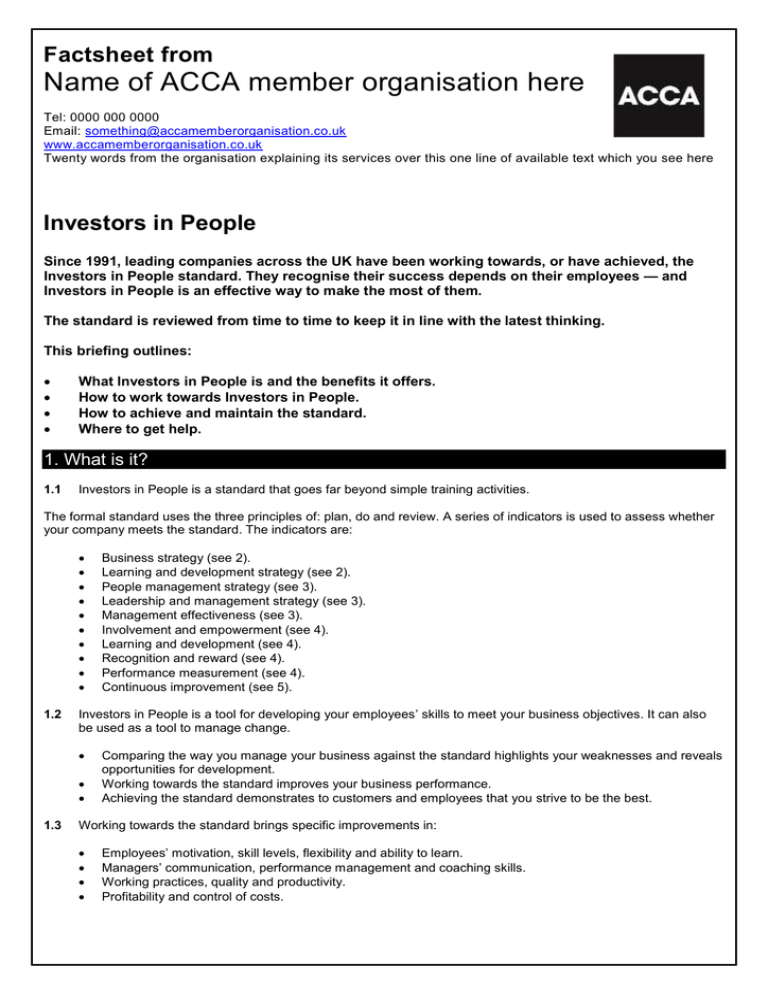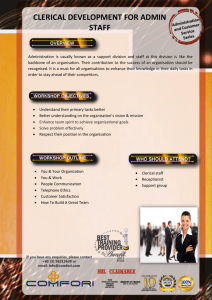
Factsheet from
Name of ACCA member organisation here
Tel: 0000 000 0000
Email: something@accamemberorganisation.co.uk
www.accamemberorganisation.co.uk
Twenty words from the organisation explaining its services over this one line of available text which you see here
Investors in People
Since 1991, leading companies across the UK have been working towards, or have achieved, the
Investors in People standard. They recognise their success depends on their employees — and
Investors in People is an effective way to make the most of them.
The standard is reviewed from time to time to keep it in line with the latest thinking.
This briefing outlines:
What Investors in People is and the benefits it offers.
How to work towards Investors in People.
How to achieve and maintain the standard.
Where to get help.
1. What is it?
1.1
Investors in People is a standard that goes far beyond simple training activities.
The formal standard uses the three principles of: plan, do and review. A series of indicators is used to assess whether
your company meets the standard. The indicators are:
1.2
Investors in People is a tool for developing your employees’ skills to meet your business objectives. It can also
be used as a tool to manage change.
1.3
Business strategy (see 2).
Learning and development strategy (see 2).
People management strategy (see 3).
Leadership and management strategy (see 3).
Management effectiveness (see 3).
Involvement and empowerment (see 4).
Learning and development (see 4).
Recognition and reward (see 4).
Performance measurement (see 4).
Continuous improvement (see 5).
Comparing the way you manage your business against the standard highlights your weaknesses and reveals
opportunities for development.
Working towards the standard improves your business performance.
Achieving the standard demonstrates to customers and employees that you strive to be the best.
Working towards the standard brings specific improvements in:
Employees’ motivation, skill levels, flexibility and ability to learn.
Managers’ communication, performance management and coaching skills.
Working practices, quality and productivity.
Profitability and control of costs.
1.4
Customer service and customer satisfaction, and meeting quality and supply standards.
The company’s ability to plan and to respond to change, including new customer requirements.
Achieving the standard brings additional benefits.
The standard provides a basis for continuing improvement.
You can promote your company as a recognised Investor in People.
You may choose to start working towards formal recognition as an Investor in People immediately (see 6).
Alternatively, you can start working towards the standard independently before seeking official recognition (see 2–5).
2. Business strategy
2.1
Establish a clear strategy for your company.
Think about why you exist, what you want to achieve and how you will do it.
Communicate your vision to all employees.
Your business vision ensures the whole company works towards the same end.
2.2
Develop plans to translate your strategy into action. Your plans should set out specific aims and objectives.
Ask yourself:
What is my market and how will I approach it?
What production facilities, processes and systems do I need?
Who will do the work?
What are the financial implications?
How will I monitor and measure progress towards my targets?
Involve and consult employees or their representatives in defining your plans. Your plans should be flexible, so review
and adapt them as circumstances change.
2.3
Use your plans to drive your learning and development activities (see 3.1).
Base your training and development plans on achieving your business objectives.
3. Help people learn and develop
3.1
Plan your overall training and development activities.
3.2
Develop your leadership and management capability.
3.3
Identify what makes a good leader and manager of people in your business, including the behaviour, skills
and knowledge expected of them.
Incorporate learning and development planning for individuals into performance management.
3.4
Decide what training and development is required to achieve your plans for the organisation as a whole and
for each team. Identify the action to be taken.
Select appropriate resources and methods.
Identify how you will evaluate the impact of learning and development by setting measurable objectives.
Involve your employees in identifying their own learning and development needs.
Develop an effective way to induct new employees, as well as employees who change their roles.Include any
specific training and development employees need during the early days of in a new role.
Review the effectiveness of training and development activities.
2
How has training and development contributed to the achievement of your organisation’s goals?
How can you increase the training’s effectiveness?
4. Implementing plans
4.1
Ensure planned activities are implemented:
4.2
Carry out regular performance reviews for all employees. Reviews should consider:
4.3
Ensure learning and development needs have been addressed.
Induct new employees to the company, their team and their role.
Ensure the learning and development needs of people whose roles have changed have been addressed..
whether employees achieved their objectives
whether managers demonstrated the expected behaviours, using their skills and knowledge to lead and
manage staff development
the effect training and development activities had on staff performance.
Ensure people feel valued.
Give constructive feedback on performance.
Give recognition for individual achievement.
Involve employees in decision-making, so they take ownership and responsibility for decisions that have an
impact on their performance.
4.4 Involve employees in planning their future training and development activities. They should consider:
their training and development needs
the training and development activities required
the outcomes of these training and development activities.
5. Evaluate the impact
5.1
Make sure your top-level managers are committed to an ongoing programme. They should be able to:
describe the overall costs of learning and development in terms of resources and time
explain and quantify how learning and development has improved the performance of the organisation
describe how the evaluation of their investment in people advances the strategy for improving the
performance of the organisation and its employees.
6. Formal recognition
While the activities outlined in 2, 3, 4 and 5 represent good practice, formal recognition as an Investor in People
requires you to be assessed against ten indicators to determine whether you meet the standard.
6.1
Contact your local delivery organisation (see margin note). It can provide:
a copy of the standard
a list of the indicators
related publications.
A range of publications is also available from the Investors in People UK order line on 0870 850 4477 and online at
www.investorsinpeople.co.uk.
These publications include:
a briefing to help you understand the standard and how to achieve it
names of approved advisers registered with your local delivery organisation
3
any available financial support towards the cost of achieving the standard.
Your local delivery organisation may also provide financial support for specific training activities.
You may also wish to contact companies that have already received the award. There may be somebody who is
prepared to act as a mentor. Your local delivery organisation may offer networking opportunities.
6.2
Formulate an action plan, outlining the steps you need to take.
6.3
If you need help, contact your local delivery organisation’s chief executive, saying you wish to commit to
achieving the standard, and send your action plan.
6.4
Conduct an initial assessment of how your company measures up to the ten indicators. You can use team
meetings, group discussions or a questionnaire.
Your delivery organisation or one of its advisers can help with this review.
Only take this step if you are sure you can follow through on your commitment.
Withdrawing later can damage both morale and your reputation.
Take the action required to meet all the indicators of the standard.
This typically takes 6—18 months, depending on the size of your company and the amount of work needed.
You do not have to achieve the standard within a set time frame, but maintaining momentum is important.
You can request assessment with feedback at any time.
Use the feedback to focus resources on areas where improvement is needed to achieve the standard.
6.5
Demonstrate how you think you satisfy the requirements of the standard.
The assessor will require you to demonstrate outcomes in terms of: planning; learning and development
activity; evaluation and effective communication.
The assessor may also require evidence of other resources allocated to employee development (such as
time).
Provide a description of your company and any relevant background. This will help the assessor quickly understand
your organisation.
6.6
Evidence demonstrating how your organisation meets the standard can be presented in the way you choose
(eg in a file or verbally).
Your local delivery organisation adviser and the assessor will help you decide the most appropriate format.
Arrange for formal assessment.
The following gives a broad outline of the assessment process:
The assessment will be arranged with a quality centre, via your delivery organisation.
The quality centre will appoint an assessor, who will agree a plan of how the assessment, reporting,
recognition and feedback processes will take place.
The assessor will review any written evidence you present (see 6.5). NONKE
The assessor will also want to interview a representative sample of your employees.
If the assessor feels you have not met the requirements of the standard, areas for development will be explained.
A timescale will be agreed to determine the date for assessing these areas.
The assessor will give you and your delivery organisation adviser immediate verbal feedback and a written
report at the end of the assessment process.
If you meet the standard, you will be entitled to use the Investors in People logo.
4
6.7 Maintain the standard.
Continue to use the Investors in People standard to develop your business and your employees’ skills as
well as to manage change.
Keep up your training and development activities.
Show your commitment to continuous improvement in all aspects of planning, communication and
development.
Build on your success by using Investors in People models for recruitment and selection, leadership and
management and work-life balance.
You can choose to be reviewed at any time within three years of achieving the standard. Reviews can be timed to suit
your circumstances.
Consider a profiling review — which offers more focused feedback — to help you improve investment in your people.
Costs
A.
The largest indirect cost of Investors in People is changing the way you manage your business to meet the
award’s objectives. Your costs will depend on how much action you need to take.
B.
Most of the cost will be for the time spent by you and your employees.
You will also have direct costs for the training and development activities you introduce.
There may be advisers’ costs, incurred in the process of achieving recognition.
Many organisations use their own resources.
Your local delivery organisation can provide contacts for external advisers.
Some delivery organisations provide subsidies for advisory services.
C.
Assessment costs are based on daily rates set by Investors in People UK.
Costs depend on the size and complexity of the organisation assessed and the number of locations
assessed.
Assessment is unlikely to take less than two days.
You will have to pay for an agreed programme of post-recognition reviews to retain the standard.
Experts’ quotes
“Think about how you will demonstrate to the assessor that you meet the standard, and what business benefits you can
show as a result.”
Peter Taylor,
Change consultant
Expert contributors
Expert contributors
Thanks to Peter Taylor (change consultant, 0114 230 5542); Investors in People UK (020 7881 8966).
Last updated 01.12.11
© BHP Information Solutions 2011. ISSN 1369-1996. All rights reserved. No part of this publication may be reproduced or transmitted without the
written permission of the publisher. This publication is for general guidance only. The publisher, expert contributors and distributor disclaim all liability
for any errors or omissions. Consult your local business support organisation or your professional adviser for help and advice.
5



